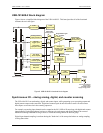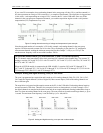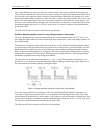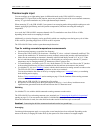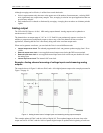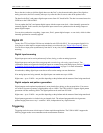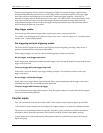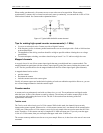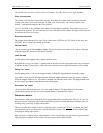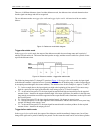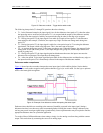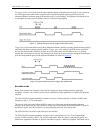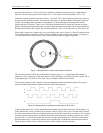
USB-1616HS-2 User's Guide Functional Details
25
Hardware analog triggering
The USB-1616HS-2 uses true analog triggering in which the trigger level you program sets an analog DAC,
which is then compared in hardware to the analog input level on the selected channel. This guarantees an analog
trigger latency that is less than 1 µs.
You can select any analog channel as the trigger channel, but the selected channel must be the first channel in
the scan. You can program the trigger level, the rising or falling edge to trigger on, and hysteresis.
A note on the hardware analog level trigger and comparator change state
When analog input voltage starts near the trigger level, and you are performing a rising or falling hardware
analog level trigger, the analog level comparator may have already tripped before the sweep was enabled. If this
is the case, the circuit waits for the comparator to change state. However, since the comparator has already
changed state, the circuit does not see the transition.
To resolve this problem, do the following:
Set the analog level trigger to the threshold you want.
Apply an analog input signal that is more than 2.5% of the full-scale range away from the desired
threshold. This ensures that the comparator is in the proper state at the beginning of the acquisition.
Bring the analog input signal toward the desired threshold. When the input signal is at the threshold
(± some tolerance) the sweep will be triggered.
Before re-arming the trigger, again move the analog input signal to a level that is more than 2.5% of the
full-scale range away from the desired threshold.
For example, if you are using the ±2 V full-scale range (gain = 5), and you want to trigger at +1 V on the rising
edge, set the analog input voltage to a start value that is less than +0.9 V (1 V – (2 V * 2 * 2.5%)).
Digital triggering
A separate digital trigger input line is provided (TRG), allowing TTL-level triggering with latencies guaranteed
to be less than 1 µs. You can program both of the logic levels (1 or 0) and the rising or falling edge for the
discrete digital trigger input.
Software-based triggering
The three software-based trigger modes differ from hardware analog triggering and digital triggering because
the readings—analog, digital, or counter—are checked by the PC in order to detect the trigger event.
Analog triggering
You can select any analog channel as the trigger channel. You can program the trigger level, the rising or falling
edge to trigger on, and hysteresis.
Pattern triggering
You can select any scanned digital input channel pattern to trigger an acquisition, including the ability to mask
or ignore specific bits.
Counter triggering
You can program triggering to occur when one of the counters meets or exceeds a set value, or is within a range
of values. You can program any of the included counter channels as the trigger source.




